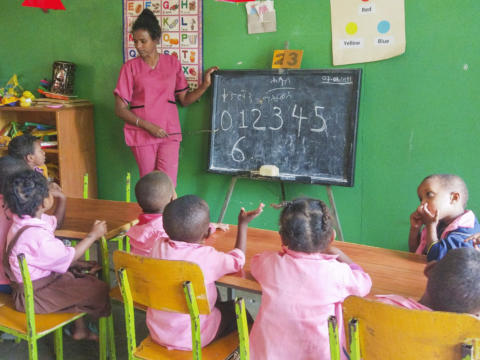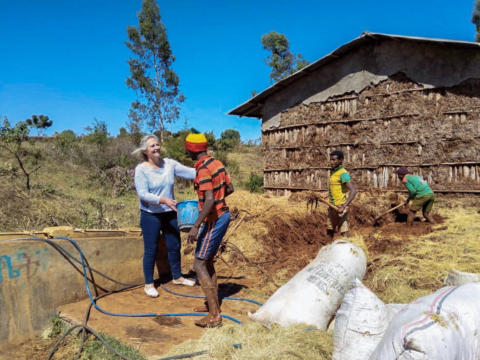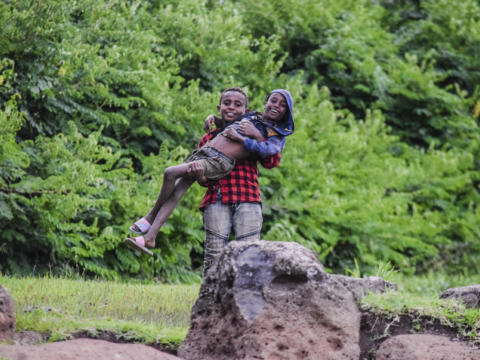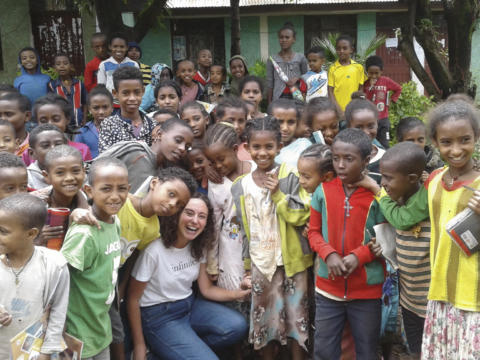Only 450€ per week!
Ethiopia Road Trip
Southwest by South - Ethiopia
Ethiopia! A country that encompasses a large chapter of human evolution that goes back to the very beginning of known civilizations. The road less travelled will give you a window to explore this magical country with its amazing natural & agricultural shaped terrains, from the plains to the highlands.
Ethiopia has it all! Join us and get up close to the mystique & spellbinding adventures coming your way.
Program Description
Ethiopia has been at the crossroads of trade amongst continents for centuries & the lineage of homosapiens millions of years ago. ‘Lucy ’ the first human remains was found in Ethiopia and it is still on display at The National Museum in Addis Ababa.
Ethiopia’s architecture has a mix of various cultures & religions. In this journey from the north towards Southwest to South, you will discover this amazing country in its purest form.
What’s included
- Visit Axum historical sites
- Simien Mountains trek
- Guided tour of Debre Berhan Selassie Church, Fasiladas's Bath, and historic castles in Gondar
- Boat trip on Lake Tana
- Excursion to Blue Nile Falls
- Guided tour of the rock-hewn churches of Lalibela
- Presence of a dedicated program coordinator throughout your travel, at the projects and facilities- Logistical management support in case of emergencies
- Various cuisine for breakfast, lunch & Dinner) for the duration of the entire program.
- Accommodation at hotels, and at our accommodation facility – shared accommodation
- Entry fees to all places specified in the schedule.
- Extensive pre-departure information
- Overland local public transportation
What’s Excluded
- Cost of Internal Flights to Axum & from Lalibela
- Not Included Transfer to Airport for Departure to Addis Ababa
- Personal expenses such as table drinks, room service items, laundry, telephone calls, tips, porterage at hotels or airport, bottles of water during your road travel etc.
- Any additional expenses caused by or liability for disturbance in the program due to circumstances, weather conditions, sickness, natural disasters, riots, etc.
- Liability for or insurance against injury, loss of life, accidents or loss of goods
- Our program does not cover any liability and does not insure participants. Participants must have appropriate insurance before joining the program
- Any Service not specified.
Few things to consider while you are with us
- Be back at the accommodation by 22:00 everyday
- Participants will not be entertained to hire any vehicles on their own
- Consumption of alcohol is strictly prohibited in our Centers
- Respect and adherence to our code of conduct is expected
- Our staff are there to support you and to guide you and make your trip memorable, we request you to kindly follow their instructions at all times.
- You will not be allowed to bring outsiders inside our centers, guest houses or hotels
Aims & Objectives
The aim of this program is to bring you closer to authentic Africa and to truly immerse you into the culture, customs and lifestyle. This program will also give an opportunity to take part in community engagement projects and activities to understand local community lifestyle.
Schedule
Week 1
Day 1: Sunday
Upon arrival, you will be transferred to accommodation in Axum from the airport. At the accommodation you will receive a briefing on culture, traditions and a narrative of the circuit of your route. You will also learn the Dos and Don’ts in Ethiopia. Overnight stay is in Axum.
Day 2-3: Monday to Tuesday
We will explore Axum and learn about its culture, architecture and history. Axum is a World Heritage Site. The remnants of Axum's past are huge granite pillars, fallen some still perpendicular and the largest monolith in the world. Made of single blocks of granite, the tallest stood over 33 metres high – The biggest now sting is 23 metres high. Axum was the heart of Ethiopia when it was the most powerful between the Eastern Roman Empire and Persia. Even after its political collapse in the 10th century, Ethiopian emperors continued to be crowned in Axum.
At this time Arabian immigrants started arriving in the Ethiopian highlands, bringing with them their unique and diverse gods across the Red Sea. They brought along the tradition of colossal stone building that would profoundly influence the region’s architectural and religious beliefs.
Axum’s artistic heritage is the product of a series of transcontinental cultural exchanges as far as the late first millennium B.C.
Day 4-5: Wednesday to Thursday
Spend the day in Simien Mountains National Park, a UNESCO World Biosphere Reserve site with its scenic views wildlife in the late afternoon.
Views of the stunning mountain ranges at the scenic lodge with The Simien Mountains National Park in Northern Ethiopia is an exotic location. The natural beauty of this region has always enthralled visitors with awe.
With unique wildlife and breathtaking views on a landscape shaped by nature and agriculture, a good trek will be organized to get up and close with your surroundings. Settings of grasslands, isolated trees and the bizarre Giant Lobelia (Medicinal Plant), are found on the high plateau with gentle high ridges at altitudes above 3600m above sea level. You will also catch a glimpse of the red chested Gelada baboon.
Day 6-7: Friday to Saturday
We will drive to Gondar and enjoy an excursion in a rural Amhara community. This is a definite stop on Ethiopia's Historic Route and it is also called the 'Camelot' of Africa. Once glorious with Emperors, Kings Churches, Gondar is now a centre of learning for the Ethiopian Orthodox Church.
Gondar Castle is not a single castle, but it is the name given to an entire complex of 11 castles and palaces in the area. It is also a UNESCO World Heritage Site. The best of Gondar’s imperial structures is the two-storeyed palace built of roughly hewn brown basalt stones with mortar that hold the structure together. It is said to have been the work of an Indian architect with towers and battlemented parapets.
Gondar, when it was the Ethiopian capital, was home to a number of emperors, warlords, courtiers and kings in the seventeenth and eighteenth centuries. It is easy to imagine the mystery and pageantry that took place back in time. Overnight stay is in Gondar.
Week 2
Day 8: Sunday
It’s a morning drive to for Bahir Dar.
In Bahir Dar, we will take a couple of hours for a well-deserved rest, have lunch and you will be given an insight into our community outreach program. You can be a part of our efforts for community development while we will stay in Bahir Dar.
Bahir Dar sits on the Southern shore of Lake Tana, source of the Blue Nile. It is the largest lake in Ethiopia. With a relaxed air, a vast lake dotted with ancient island monasteries, Bahir Dar is a great place to refresh and recoup in Ethiopia. The picturesque town of Bahir Dar is the gateway to 37 ancient monasteries that dot the shores islands of Lake Tana. Appreciating natural and cultural importance in 2015, the Lake Tana region was nominated as a UNESCO World Biosphere Reserve.
We will take a stroll and explore this vibrant modern city with its unique culture and tradition, evolving over time.
Then join an evening cultural program with an introduction to Ethiopian dances and music. Overnight stay is at the Centre in Bahir Dar.
Day 9: Monday
Let’s take a boat ride on Lake Tana & visit these mysterious churches on the islands.
There are thirty-seven Islands and Churches scattered on the Lake and some twenty of them shelter monasteries. It offers immense historical-cultural interest for a visitor to explore many other islands off the tourist map.
The monasteries house beautiful mural paintings, kings’ crosses, manuscripts, crowns clothes of former kings. You can also shop for unique handicrafts made by the communities on the islands..
There’s a calmness to the place and the museums at Azwa, Ura or Mehal Zege give an impression of just how far back Christianity goes.
Day 10-12: Tuesday to Thursday
Community Outreach
Interact with the youth from 6th to 8th Grades at a local school and engage in pointing out your country of origin on a world map with pointers for Geography. You can engage the students in a dialogue that will improve their English fluency. You may also assist in our Construction and Renovation efforts in Bahir Dar during the days.
Day 13: Friday
Visit the local markets and pick up ingredients that you would like for lunch to get into an introduction to Ethiopian Cuisine while being a part of the traditional cooking lesson. After lunch, you will visit one of the most well-known waterfalls in Africa, the Blue Nile. It is the major tributary of the great Nile River, the longest river in the world. The Blue Nile River starts from Ethiopia's Lake Tana and joins the smaller tributary White Nile at Khartoum Sudan to form the Nile River.
It has been confirmed that the White Nile originates in East Africa's Lake Victoria and the Blue Nile starts out of Ethiopia's Lake Tana. Blue Nile Falls is the most dramatic spectacle that this whole ecosystem has to offer. It is Four hundred metres (1,312 feet) wide when in flood (which normally occurs in the rainy season) flows over a vertical drop of more than forty-five metres (150 feet).
The waterfall throws up a continuous spray of water droplets which drench onlookers up to a kilometre away, which normally occurs in September October, after the rainy season.
This misty water produces rainbows that shift shimmer across the gorge a perennial rainforest of lush green vegetation, much to the delight of the innumerable monkeys and multi-coloured birds that inhabit the gorge.
Day 14: Saturday
After lunch, we will explore Lalibela where you will witness the 11 interconnected churches, carved into the mountain by hand which is a feat of tremendous skill. Labella’s churches were dug straight into the ground, hewn out of solid rock.
Lalibela is best known for its Church of St. George which is shaped like a Greek Orthodox cross. These 11 medieval monolithic cave churches are situated in a mountainous region. Lalibela is an extremely important place with regard to Ethiopian Christianity until today it’s a site of pilgrimage and devotion.
Also close to a traditional village, you will find circular-shaped homes. It’s a small, rural village and an unassuming place set amidst a stunning high landscape. We will stay overnight in Lalibela.
Week 3
Day 15: Sunday
Continue Exploring Lalibela.
Day 16: Monday
Early flight back to Addis Ababa. You may freshen up in a transit room before we proceed to Omo Valley the same day.
Day 17-19: Tuesday to Thursday
Omo Valley
On the border of Ethiopia and Kenya is an ancient culture consisting of people who have been living very much as their ancestors did for centuries. In a part of the Great Rift Valley, you find the proud people of Omo Valley whom time seems to have forgotten. You will get exposed to an ancient culture, traditional lifestyles and heritage
Day 20: Friday
Early transfer back to Addis Ababa and freshen up in a transit room.
Day 21: Saturday
Departure
Note: Mode of transportation could change due to unavoidable circumstances
Note: This schedule can be changed and/or amended depending on weather conditions, local conditions and unforeseen circumstances.
Participant Criteria & Requirements
Standard Requirements
Minimum age: –
Maximum age: –
Minimum English level: Basic
CRB required: On Signup
Passport copy required: On Signup
Resume copy required: No
Required qualification: None
Additional Requirements
- Yellow fever vaccination is mandatory for all participants arriving in Ethiopia.
- Due to the length and active nature of this program, a decent level of fitness is required.
- Participants below the age of 18 should have parental consent.
- Participants above the age of 65 should have medical clearance.
Additional Equipment
- Medicines you may require: if you have to take specific medicines on a regular basis, bring them along Otherwise, be aware that most basic medicines and even antibiotics are available in Ethiopia for which you should have a doctor’s prescription.
- First-aid kit should contain lip balm with sunscreen, sunscreen, whistle, Aspirin, Ibuprofen, bandaids/plasters, tape, antihistamines, antibacterial gel/wipes, antiseptic cream, Imodium or similar tablets for mild cases of diarrhea, rehydration powder, water purification tablets or drops, insect repellent, sewing kit, extra prescription drugs you may be taking
- A sleeping bag, warm clothes and rain jackets
- Mosquito repellents/mosquito nets
- Hiking shoes or trainers
- Please bring a rucksack (backpack), avoid trolleys and suitcase to make you travel comfortably
- Modest clothing that covers knees and shoulders such as Long pants, long skirts, shirts that cover shoulders
- Shawl or scarf for temple visits
- Cash, credit and debit cards
- Day pack (Used for daily excursions or short overnights)
- Flashlight/torch
- Fleece top/sweater
- Locks for bags
- Outlet adapter
- Toiletries – Preferably biodegradable
Location
Bahir Dar is a bustling city with palm tree and flower lined roads and is located in the Amhara region where Amharic is widely spoken. Lake Tana, a World Heritage Biosphere Reserve and the Blue Nile Falls are located nearby.
Daily flights connect Bahir Dar to Addis Ababa. Bus services from Addis Ababa to Bahir Dar entail a very comfortable bus journey of 10 hours rewarded with scenic views along the way. Your accommodation is on the outskirts of Bahir Dar, about 3 to 4 kilometers from the projects, and is part of a gated community. The house overlooks Lake Tana and the Abyssinian Highlands.
About Axum
The remnants of Axum's past are huge granite pillars, fallen and some still perpendicular & the largest monolith in the world .Made of single blocks of granite, the tallest stood over 33 metres high – The biggest now standing is 23 metres high.
Axum was the heart of Ethiopia when the Axum was the most powerful between the Eastern Roman Empire and Persia. Even after its political collapse in the 10th century, Ethiopian emperors continued to be crowned in Aksum. And at this time Arabian immigrants started arriving in the Ethiopian highlands. Across the Red Sea, bringing with them their unique & diverse gods. Along with tradition of colossal stone building that would profoundly influence the region’s architectural and religious beliefs. Artistic heritage is the product of a series of transcontinental cultural exchanges as far as the late first millennium B.C. & a system of writing that existed.
About Simien Mountains
Simien Mountains National Park, a UNESCO World Biosphere Reserve site. Views of the stunning mountain ranges at the scenic lodge with The Simien Mountains National Park in Northern Ethiopia is an exotic location. The natural beauty of this region have always enthralled visitors with awe.
With unique wildlife and breathtaking views on a landscape shaped by nature & agriculture. A good trek will be organized to get up & close with the nature of your surroundings. Settings of grasslands, isolated trees and the bizarre Giant Lobelia (Medicinal Plant) are found on the high plateau that ends abruptly at 1000- to 2000-m deep escarpments & gentle highland ridges at altitudes above 3600 meters above sea level. You can catch a glimpse of the red chested Gelada baboon.
About Gondar
A definite stop on Ethiopia's Historic Route is what has been called the 'Camelot' of Africa”. Emperors, Kings and Churches. Gondar is now a centre of learning for the Ethiopian Orthodox Church. Gondar Castle, is not a single castle, but comprises is the name given to the entire complex of 11 castles and palaces in the area.
The best of Gondor's imperial structures is the two-storeyed palace built of roughly hewn brown basalt stones with mortar that holds the structure together. Said to have been the work of an Indian architect with towers and a battlemented parapet. Gondar, then the Ethiopian capital, was home to a number of emperors and warlords, courtiers and kings in the seventeenth and eighteenth centuries. It is easy to imagine the mystery and pageantry that took place back in time
About Bahir Dar
Bahir Dar is a great place to refresh & recoup in Ethiopia. Bahir Dar sits on the Southern shore of Lake Tana, source of the Blue Nile and the largest lake in Ethiopia. The picturesque town of Bahir Dar is the gateway to 37 ancient monasteries that dot the shores and islands of Lake Tana
Appreciating its national and international natural and cultural importance in 2015, the Lake Tana region was nominated as UNESCO Biosphere Reserve. By African norms Today, Bahir Dar is a clean, safe and well maintained city with access to the 20 monastic churches going back to the 14th Century.
Islands & Churches There are thirty seven of them scattered on the Lake and some twenty of them shelter monasteries that offer immense historical, churches and cultural interest for a visitor to explore many other islands of the tourist map. The monasteries housing beautiful mural paintings, kings’ crosses, manuscripts, crowns and clothes of former kings & shop for unique handicrafts made by the communities on the islands. There’s a calmness to the place, and the museums at Azwa, Ura or Mehal Zege, an impression of just how far back Christianity goes. After the rains enjoy a walk between monasteries & islands, rather than only hopping around in a boat.
About Lalibela
The 11 interconnected churches, carved into the mountain by hand and Unusual skills with the fact that Lalibela's churches were dug straight into the ground Hewn out of solid rock.
Lalibela is best known for the Church of St George, shaped in a Greek Orthodox cross. The 11 medieval monolithic cave churches of this 13th-century 'New Jerusalem' are situated in a mountainous region in the heart of Ethiopia . Close to a traditional village contain circular-shaped dwellings. Lalibela is a high place of Ethiopian Christianity, still today a site of pilgrimage and devotion. Lalibela is a town soaked in magic and mysticism as well. A small, rural village, an unassuming place set amidst a stunning highland landscape, Lalibela is a UNESCO World Heritage Site.
About Omo Valley
On the border of Ethiopia & Kenya is one of the last bastions of an ancient culture consisting of people who have live very much as their ancestors did for centuries.
In an isolated part of the Great Rift Valley are the proud people of the Omo Valley that time seems to have forgotten. Exotic tribes steeped in an ancient culture, traditional lifestyles & ancient customs.
About the Accommodation
Along the route you will have overnight stays in hotels/guest houses, busses and trains. More information can be found inside the schedule.
Food Arrangements
Your meals will be mainly Ethiopian dishes. Vegetarian dishes will be available most of the days and non-vegetarian twice a week.
Facilities
Facilities include first aid equipment as well as coordinator support. Supermarkets, cafes, shops, ATMs are available nearby.
Activities & Events
No scheduled activities outside the program.
Sights & Surroundings
You’ll be on a busy schedule.
Transportation
From this location we do not provide free transport to other locations.
Quick Facts
Name: Federal Democratic Republic of Ethiopia
Population: 102 million
Capital: Addis Ababa
Language: Amharic, English
Currency: Birr (ETB)
Time zone: CST (UTC +3)
Country Information
A country with a unique cultural heritage, the home of the Ethiopian Orthodox Church – one of the oldest Christian denominations – and a monarchy that ended only quite recently. Dating to prehistoric times and also having Biblical references, Ethiopia has a rich and varied history. Ethiopians pride themselves of never being colonized except for a five year period during Mussolini's occupation. Coupled with its beautiful highlands and desert it is a traveler’s delight. Addis Ababa the largest city and capital is like any other city with all its modern trappings. Culture, cuisine, wildlife, welcoming hospitality, these and many other experiences await you in this ancient and modern land. As Ethiopians like to say, "Come and enjoy, 13 months of sunshine!"
Climate
Predominantly of a tropical monsoon weather, but due to the Ethiopian Highlands which cover most of the country, Ethiopia experiences a climate which is generally considerably cooler than other regions at similar proximity to the Equator. Most of the country's major cities are located at elevations of around 6,500 to 8,000 feet above sea level.
Most major cities and tourist sites in Ethiopia lie at a similar elevation to Addis Ababa and have a comparable climate. In less elevated regions, particularly the lower lying Ethiopian xeric grasslands and shrublands in the east of the country, the climate can be significantly hotter and drier. Dallol, in the Danakil Depression in this eastern zone, has the world's highest average annual temperature of 34 °C (93.2 °F).
Culture
From Music and Dance to Attire and Customs, Ethiopia is unique in its own way. The blend of traditional and modern can be seen in its architecture to the way its people dress up and conduct their day to day lives. Steeped in religious roots its culture is as vibrant as any other modern countries’ but its traditions are always visible, never having been hidden or forgotten. The Ethiopian calendar is one of the most unique in the world today that is still being followed. It has 13 months, with 12 months of 30 days each. The last month has 5 days in a common year and 6 days during a leap year.
Gastronomy
Various vegetable and meat side dishes and entrees are the main of staples of Ethiopian cuisine, often prepared as a "Wat" or thick stew. One or more servings of wat are placed upon a piece of Injera, a large sourdough flatbread, which is about 20 inches in diameter and made out of fermented Teff flour. Injera is used, always with the right hand, to scoop up the entrees and side dishes. Pork or seafood, aside from fish, is not used, as most Ethiopians have historically adhered to Islam, the Ethiopian Orthodox Church, or Judaism, all of which prohibit the consumption of pork. Orthodox Christians observe numerous fasts, such as Lent, during which food is prepared without any meat or dairy products. Another dish served in Ethiopia is Doro Wat, which is a chicken stew with hard boiled eggs.
Transportation
Air
Air transport is easy and swift in Ethiopia with their national carrier, Ethiopian Airlines which operates across around 30 domestic cities and towns across the country.
Rail
The National Railway Network of Ethiopia owned by the Ethiopian Railway Corporation (ERC), which is mostly in planning and construction stage and currently consists of four electrified standard gauge railway lines: the Addis Ababa Light Rail, the Addis Ababa–Djibouti Railway, both of which are operational. The Awash–Weldiya Railway and the Weldiya–Mekelle Railway are under construction.
Road
With around 100,000 kilometers of asphalted roads, Ethiopia is well connected. All of Ethiopia’s cities are served by public transport, including trains and buses. Taxis charge according to the meter.





